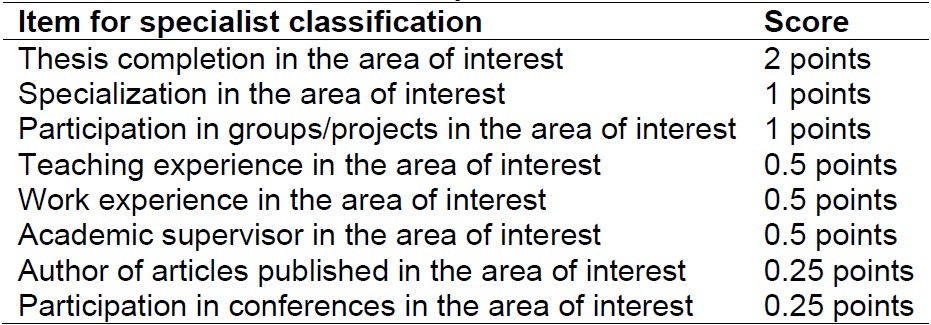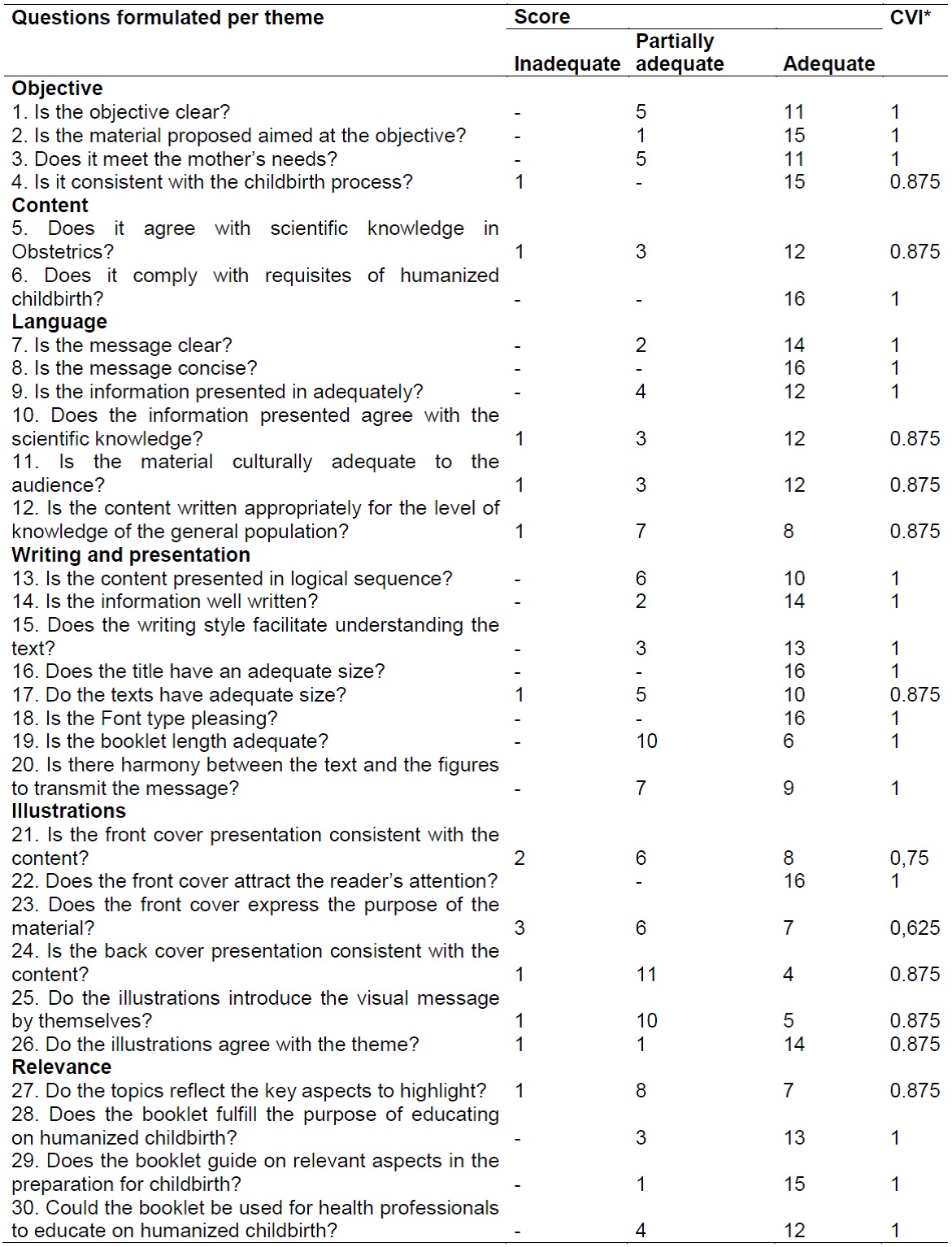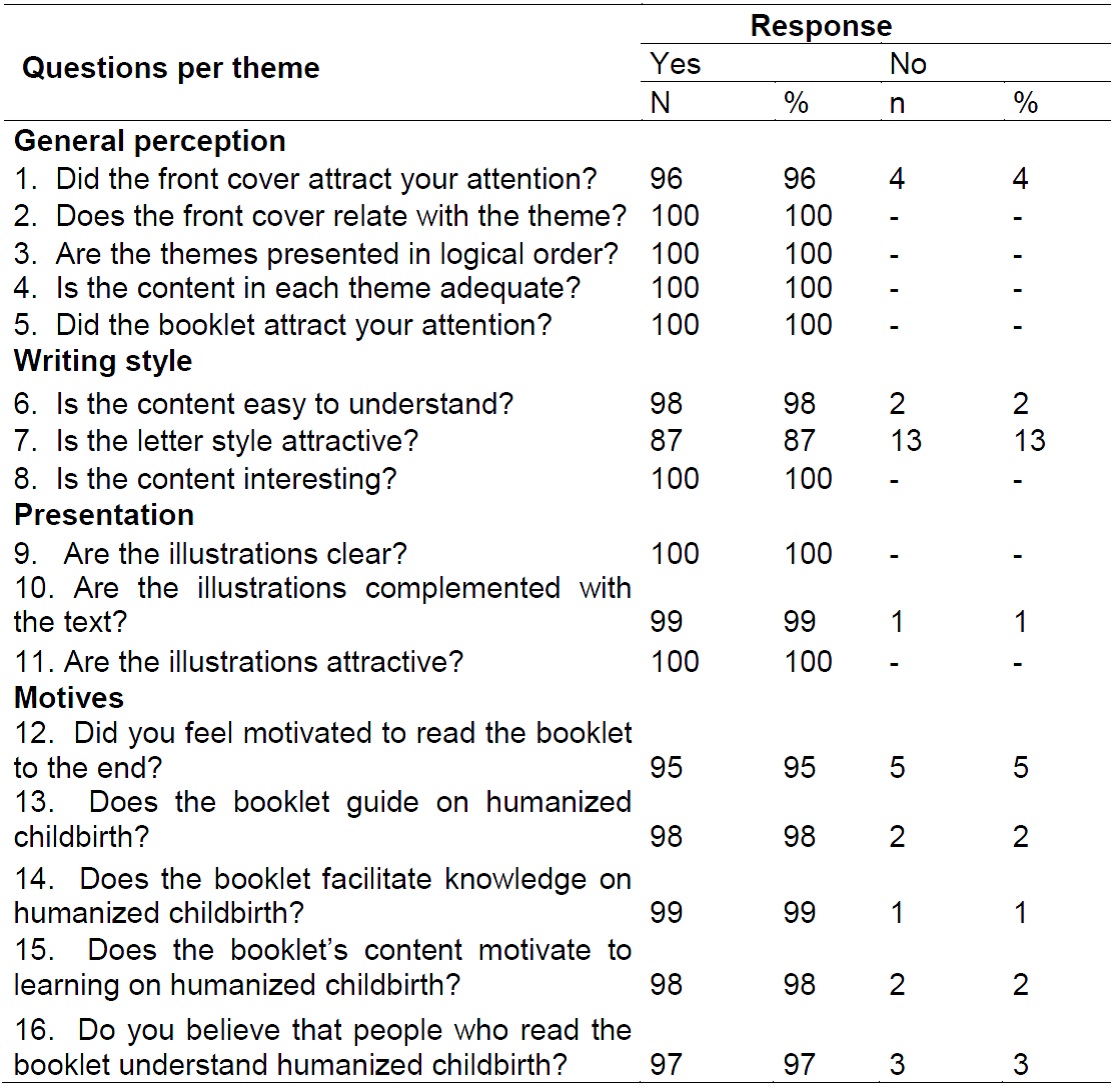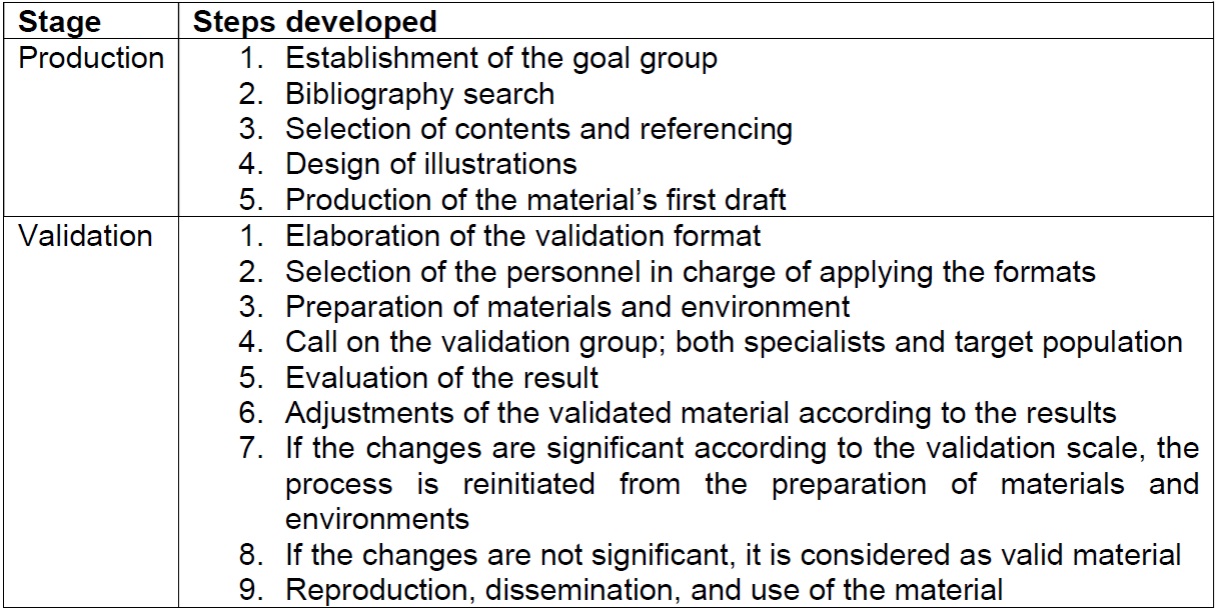My SciELO
Services on Demand
Journal
Article
Indicators
-
 Cited by SciELO
Cited by SciELO -
 Access statistics
Access statistics
Related links
-
 Cited by Google
Cited by Google -
 Similars in
SciELO
Similars in
SciELO -
 Similars in Google
Similars in Google
Share
Enfermería Global
On-line version ISSN 1695-6141
Enferm. glob. vol.19 n.60 Murcia Oct. 2020 Epub Dec 21, 2020
https://dx.doi.org/10.6018/eglobal.412771
Originals
Elaboration and Validation of a Booklet on Humanized Childbirth
1Enf. MsC Epidemiología. PhD Salud Pública. Docente Departamento de Salud Pública. Escuela de Medicina. Universidad Industrial de Santander. Bucaramanga. Colombia. fmcacer@uis.edu.co
Directora Grupo de Investigación en Demografía, Salud Pública y Sistemas de Salud - GUINDESS. Universidad Industrial de Santander. Bucaramanga. Colombia.
2Médica, Universidad Industrial de Santander, Bucaramanga, Colombia.
Introduction:
Humanized childbirth care focuses on the good treatment of pregnant women; however, some mothers experience obstetric violence, which affects their wellbeing. It is necessary to have validated tools that permit informing, communicating, and educating on practices that contribute to making the delivery process a humanized experience.
Methods. This was a validation study consisting on the development of an educational-communicative booklet on humanized childbirth, from a bibliography review, along with subsequent validation by 16 specialists and 100 participants from the target population, in 2020.
Results:
The specialists scored the booklet with a content validity index (CVI) median of 0.94 and Cronbach’s alpha reliability of 0.81. In the target population, the level of positive response ranged between 87% and 100%, with a median of 97.9%.
Discussion:
Through a literature review and by heeding to writing details, form, and depth, the study managed to elaborate a booklet that showed high CVI to provide education on humanized childbirth to pregnant women and relatives. Study strengths included process rigor, pollster suitability, and simple size. The principal weakness is that information collection was carried out in health institutions.
Conclusions:
The booklet elaborated is valid to guarantee understanding, by mothers and their relatives, of humanized childbirth. It is considered relevant and innovative material to educate on this theme, as an impacting event in the lives of the mother-child binomial and their family.
Key words: Humanizing Delivery; Communication; Education; Validation Studies
INTRODUCTION
Humanization in providing health services, understood as human-centered care, is a challenge, given the conditions and commitments that must be fulfilled by institutions and health staff 1. The aim of humanization is to concentrate care on the individual’s, rights, needs and expectations of the women as the protagonist, seeking for their optimal health and wellbeing2. Within this context, it is expected that delivery care becomes a loving, pleasant, and positive experience 2. However, some mothers manifest having gone through obstetric violence. This is cause for concern, especially when globally 830 women die due to preventable causes related with gestation and childbirth; 16.7% of them due to complications during delivery 3 because of outcomes related with abuse 4.
In search for the highest level of humanized care during childbirth, programs have been promoted to improve the quality of care 5. Thus, the International Conference on the Humanization of Childbirth, in Fortaleza, Brazil, established the search for wellbeing as a factor of progress and human development for the players in the process: mother, child, and family 6. This makes necessary to have strategies and validated tools that permit communicating and educating on practices that contribute to turning childbirth into a humanized experience for pregnant women and their families. Educommunicative strategies generate knowledge and attitudes in the construction of environments and spaces for dialogue and respect 7, with the advantage of encompassing different areas of knowledge and achieving citizen participation 8.
In this sense, the educommunicative booklets are strategies proven through investigation-action, as useful to reach changes in relation to the perceptions and behaviors of the individuals 9, with positive impact on education and generation of participation settings 10. This requires an adequate validation process, to guarantee levels of understanding and comprehension of the different factors intervening, in this case, on humanized childbirth care 11. The aim of this study was to elaborate and validate a booklet on humanized childbirth to disseminate knowledge on the theme among pregnant women and the general population in Colombia.
METHODS
Elaboration and validation was conducted on an information, education, and communication booklet on humanized childbirth. This included a process of production, evaluation, and improvement of the booklet in Bucaramanga, Colombia, during December 2019 11. Table 1 displays the stages and steps followed.
The goal group was established as being that to which the booklet is directed, a population that could be interested in the care of humanized childbirth, especially women in reproductive age, pregnant women, and their relatives. The exclusion criterion considered those individuals who had cognitive disability that hindered comprehension of the booklet.
Thereafter, the bibliography search was conducted in the LILACS, SCIELO, and PUBMED databases, using the keywords: humanized childbirth, obstetric violence, and educational-communicative strategies, resulting in 56 scientific articles. The study also reviewed national 12 and international 13,14 norms and guidelines on humanized childbirth.
The contents for the booklet were selected by bearing in mind relevant information, obtained from the previous search. The booklet was organized via the following themes: a. rights of women during childbirth and postpartum; b. duties of the women; c. unnecessary practices during low-risk childbirth; c. when to attend the health service due to the start of the delivery?; d. stages of childbirth; e. complications of delivery and childbirth; and f. role of the companion during delivery and childbirth.
The illustrations were designed in digital format based on the reflexive reading of the contents. The booklet sought to transmit the message of humanization in the contents through attractive and harmonious illustrations according to situations alluding to humanized childbirth. The initial version of the booklet had 12 pages in color, with dimensions of 14 cm by 22 cm.
The second stage elaborated two validation formats. One aimed at specialists, another to mothers and relatives. The questions for the formats were adapted from those used in prior studies by Piaui 10 and Ceara 15 in Brazil, respectively. The specialists were asked to assess objective, content, language, structure, presentation, illustrations, and relevance of the booklet, using Likert-type scoring options, like inadequate, partially adequate, and adequate. The content validity index (CVI) was calculated, which suggests considering acceptable an index > 0.60 and discarding or reevaluating those below said value 16. Pregnant women and relatives evaluated: a. general perception of the booklet; b. writing style; c. presentation; and d. motives. In this case, the scoring system was adopted with dichotomy yes/no responses. For the total adequacy rating, the sum of scores obtained was divided by the maximum score and multiplied by 100, to transform it into percentage (%). It was established that scores between 70% and 100% correspond to approved material; between 40% and 69% material subject to changes; and 0% to 39% to inappropriate material.
The tools were applied by two physicians, young researchers, experienced in approaching human beings and trained in the application of research instruments.
Prior to opening the call for the group of experts, specialists in the field of interest were defined as professionals with specific knowledge in gynecology and Obstetrics, public health, and humanization of care. Sixteen specialists were chosen, selected intentionally due to their suitability, according to that expressed in their curriculum vitae, using a scale from 1 to 6 in which each potential participant should obtain at least four points 17, as shown in Table 2. Contact was made in their places of work, along with the invitation to participate, the procedure and signing the informed consent. The place and date to apply the tool was agreed upon, according to the specialist’s availability.
Table 2. Selection criteria of specialists in the area of interest

Adapted from Sheyla C. et. al.10 and Holanda de Moura I. et. al.15
The population of interest was comprised of 100 individuals, between mothers and relatives who were contacted in the outpatient or hospitalization services in a private institution caring for people from all social security regimes. The participants were explained the objectives of the validation process, informed consent, delivery of the booklet, and evaluation of such according to the format.
The findings were transcribed in separate databases in Excel in double tabulation and verification of digitization quality. Upon correcting the databases, these were exported to analyze the information in the Stata14 statistical progrAm
RESULTS
A booklet on humanized childbirth was designed, aimed at the general public, especially pregnant women and their relatives. In 12 brief and attractive pages with color illustrations, the booklet introduces theoretical content on humanized childbirth, based on findings from the literature, national legislation, and international agreements. To guarantee interactivity, an alphabet soup was used with keywords from the humanization process in childbirth care.
Sixteen experts validated the booklet, among these: nurses, general physicians, gynecologists, and health professionals. Table 3 shows the format questions, number of specialists who scored them in each of the scale options and the respective CVI.
Table 3. Results of the evaluation conducted by specialists in humanized childbirth.

*CVI: content validity index
As seen in Table 3, the calculated CVI was > 0.60 in all items, which indicates that the booklet’s content is valid. Items 6, 8, 16, and 22 were scored as adequate by all the experts, which show that the message is concise, explains what humanized childbirth is, the title size is adequate and the front cover attracts the reader’s attention. The item with the lowest score was # 23: the front cover expresses the purpose of the material. Eleven items obtained scores < 1.0, principally those assessing the illustrations, but the score was always > 0.60, which is why it was deemed not to compromise the booklet’s validity. The CVI median was 0.94; Cronbach’s alpha reliability was 0.81.
For the validation performed by the target population, the positive response level ranged between 87% and 100%, with a median of 97.9%, sufficient to validate the booklet’s content. The sections of general perception and presentation had the highest results. Table 4 shows the results obtained by each question.
Table 4. Results of the evaluation conducted by target population

N: Number of people. %: Percentage
The booklet’s final version underwent minor changes in form, according to the recommendations by both groups of evaluators.
DISCUSSION
This study found that, by following the steps proposed, conducting the literature review, and minding details in writing, form and depth, a booklet can be achieved with high validity index to provide education to pregnant women and their relatives. In health, communication is an aspect of importance to inform, influence, and motivate the public, principally on themes of health promotion and disease prevention, in favor of improving the quality of life of communities 18. This educational-communicative strategy permits offering didactic information of easy comprehension to improve the population’s knowledge and satisfaction. Besides propitiating comprehensive and humanized care 18, it contributes to health education 19, its promotion, and recognition of the needs of pregnant women 10.
Validation of educommunicative materials is a process that permits understanding the theme introduced, analyzing different opinions, recognizing the importance of the socio-cultural component of the population, as well as correcting and improving the material to fulfill the objectives proposed. All this is done to identify the message that permits generating positive changes in the population’s behavior 21. Other studies have sought to provide spaces to improve the physician-patient relationship, along with empowering the population with the themes 22. Using communication has also been proposed as a means to promote physical, cognitive-emotional, and social-relational wellbeing from the information and communication technologies (ICT), given that it has been found that by adopting the strategies, there is improved quality of life 23, acceptance, level of understanding, memory of the information and of the medical instructions 24 25.
Regarding humanized childbirth, research whose aim was to promote humanized childbirth care, from an educational intervention of formation and sensitization of health professionals and pregnant women, showed a reduction in the rate of cesarean sections and their complications, besides improving maternal satisfaction and mother-fetus wellbeing 26.
Among the strengths of this study is the support from the scientific literature, follow up of a structured and organized process, besides the sample size of specialists, as well as the target population, compared with other studies. The study’s weaknesses focus on the collection of information, in relation to filling out the survey, given that in the target population it was conducted in the hospital environment, which could limit or mask the responses obtained, as well as the collection by the specialists, which was carried out in a work site with limited time to answer the survey.
CONCLUSIONS
The booklet elaborated based on the literature review on humanized childbirth is valid to guarantee understanding, by mothers and relatives, of humanized childbirth. During the validation process by experts, a CVI score above 0.60 was achieved in the 30 items, with a median of 0.94 and Cronbach’s alpha of 0.81, while the target population scored it with positive response between 87% and 100% with an average of 97.9%; which is why the booklet was deemed appropriate to educate, inform, and communicate on humanized childbirth.
The design and illustrations were carried out and organized by a graphic design professional, which is why after its validation it may be considered as relevant material to educate on humanized childbirth, as an impact event in the life of the mother-child binomial and their relatives where an adequate physician-patient relationship must exist, which leads to comprehensive care centered on the expectations and needs of the pregnant woman for which the health staff, the pregnant woman and her family must be trained.
REFERENCES
1. Ariza C. Soluciones de humanización en salud en la práctica diaria. Enferm univ. 2012; 9(1):41-51. [ Links ]
2. Nascimento FCV, Silva MP, Viana MRP. Assistência de enfermagem no parto humanizado. Rev Pre Infec e Saúde[Internet]. 2018;4:6887. Available from: http://www.ojs.ufpi.br/index.php/nupcis/article/view/6887 DOI: https://doi.org/10.26694/repis.v4i0.6887 [ Links ]
3. Organización Mundial de la Salud. Mortalidad materna. [Consultado 12 jun 2019]. Disponible en: https://www.who.int/es/news-room/fact-sheets/detail/maternal-mortality [ Links ]
4. Jaffre Y, Prual Am Midwives in Niger: an uncomfortable position between social behaviours and health care constraints. Soc Sci Med 1994; 38:1069-73. http://dx.doi.org/10.1016/0277-9536(94)90224-0 [ Links ]
5. Rocha Acero ML, Socarrás Ronderos F, Rubio León DC. Prácticas de atención del parto en una institución prestadora de servicios de salud en la ciudad de Bogotá. Rev Fac Nac Salud Pública. 2019;37(1):53-65. 10.17533/udea.rfnsp.v37n1a10. [ Links ]
6. Borges DL, Sánchez MR, Domínguez HR, Sixto PA. El parto humanizado como necesidad para la atención integral a la mujer. Rev Cuba Obstet y Ginecol. 2019;44(3). http://dx.doi.org/10.15446/av.enferm.v33n3.42015.8 [ Links ]
7. Jordán M, Behar O, Buitrago S, Castillo J. Estrategias educomunicativas para fortalecer procesos de resocialización de un grupo de adolescentes infractores en Cali. Periodismo, medios y agenda. 2017;2(22):105-19. https://doi.org/10.18046/recs.i22.2381 [ Links ]
8. Piedrahita BS. Diseño de una estrategia educomunicativa a través de un proceso de aprendizaje colaborativo secuenciado, que permita el desarrollo de la autonomía en la producción de contenidos audiovisuales, en espacios mediático- tecnológicos como lo son los magazines. Universidad Tecnológica de Pereira; 2016. [ Links ]
9. Sánchez A, Salinas W. Estrategias educomunicativas para la formación de comportamientos ambientales responsables en escenarios empresariales?: Síntesis de la experiencia en la planta de Coca Cola, sede Bucaramanga. Rev Docencia e Investig. 2016;6(2):65-77. https://doi.org/10.15332/erdi.v6i2.1650 [ Links ]
10. Sheyla C, Marcos DO, Ana C. Construcción y validación de cartilla educativa para alimentación saludable durante el embarazo. Rev Latino-Am Enferm. 2014;22(4):611-20. http://dx.doi.org/10.1590/0104-1169.3313.2459 [ Links ]
11. Ziemendorff S, Krause A. Guía de Validación de materiales educativos?: con enfoque en materiales de Educación Sanitaria. 1era Edición. Chiclayo; 2003. 1-77 p. DOI: 10.13140/RG.2.1.3560.1129 [ Links ]
12. Colombia. Ministerio de Salud y Protección Social, Colciencias. Guía de práctica clínica para la prevención, detección temprana y tratamiento de las complicaciones del embarazo, parto o puerperio. Guías No. 11-15. Bogotá 2013 [ Links ]
13. Ministerio de Salud Chile. Manual de atención personalizada en el proceso reproductivo. Primera edición. Chile: Trama Impresiones SA; 2008. [ Links ]
14. Estados Unidos Mexicanos. Secretaría de salud. Modelo de atención a las mujeres durante el embarazo, parto y puerperio enfoque humanizado, intercultural y seguro. [Consultado 10 jun 2019]. Disponible en: https://www.gob.mx/cms/uploads/attachment/file/29343/GuiaImplantacionModeloParto.pdf [ Links ]
15. Holanda de Moura I, Rodrigues da Silva AF, Holanda Rocha AES, Oliveira Lima LH, Magalhaes Moreira TM, Vollarouva Silva AR. Construction and validation of educational materials for the prevention of metabolic syndrome in adolescents. Rev Latino-Am Enfermagem. 2017;25:e2934. https://doi.org/10.1590/1518-8345.2024.2934 [ Links ]
16. Vargas Salgado M, Maynez Guaderrama AI, Cavazos Arroyo J, Cervantes Benavides LE. Validez de contenido de un instrumento de medicion para medir el liderazgo transformacional. Revista Global de Negocios. 2016;4(1):35-45. [ Links ]
17. Rocha teles LM, Souza de Oliveira A, Camara Campos F, Marques Lina T, Chaves da Costa C, Souza Gomes LF, et al. Development and validating an educational booklet for childbirth companions. Rev Esc Enferm USP. 2014; 48(6):977-84. https://doi.org/10.1590/S0080-623420140000700003 [ Links ]
18. Gonzaga NC, Muniz CC, Araujo TL. Serial album validation for promotion of infant body weight control. Rev Lat Am Enfermagem. 2018;26:e2998. http://dx.doi.org/10.1590/1518-8345.2194.2998 [ Links ]
19. Dos Santos J, Magalhães T. Booklet content validation on excess weight for adults with hypertension. Rev Bras Enferm. 2019;72(1):95-101. http://dx.doi.org/10.1590/0034-7167-2018-0105 [ Links ]
20. Garcia M, Chismark EA, Mosby T, Day S. Development and Validation of a Nutritional Education Pamphlet for Low-Literacy Pediatric Oncology Caregivers in Central America. J Cancer Educ. 2010;25(4):512-7. [ Links ]
21. Franco-aguilar A, Alzate-Yepes T, Granda-Restrepo DM, Hincapié-Herrera LM, Muñoz-Ramírez LM. Validación de material educativo del programa " Niñ @ s en Movimiento " para el tratamiento de la obesidad infantil. Rev Fac Nac Salud Pública. 2018;36(3):109-19. https://doi.org/10.17533/udea.rfnsp.v36n3a11 [ Links ]
22. Fernández Gómez E, Díaz Campo J. Comunicación sobre el cáncer en Facebook. Las asociaciones de Argentina, Chile, Colombia y España. Cuad.inf. 2016;38:35-50. http://dx.doi.org/10.7764/cdi.38.926 [ Links ]
23. Condeza A, Bastías G, Valdivia G, Cheix C, Barrios X, Rojas R, et al. Adultos mayores en Chile?: descripción de sus necesidades en comunicación en salud preventiva. CuadernosInfo. 2016;38:85-104. [ Links ]
24. Garcia M, Chismark EA, Mosby T, Day S. Development and Validation of a Nutritional Education Pamphlet for Low-Literacy Pediatric Oncology Caregivers in Central America. J Cancer Educ. 2010;25(4):512-7 [ Links ]
25. Franco-aguilar A, Alzate-Yepes T, Granda-Restrepo DM, Hincapié-Herrera LM, Muñoz-Ramírez LM. Validación de material educativo del programa " Niñ@s en Movimiento " para el tratamiento de la obesidad infantil. Rev Fac Nac Salud Pública. 2018;36(3):109-19. [ Links ]
26. Gracia R. La promoción del parto humanizado a través de una intervención educativa en el contexto hospitalario. 2016. [ Links ]
Funding sourcesThis study was nested in the project entitled “Prevalence and factors associated with humanized childbirth in seven cities in Colombia 2018” approved by the Institutional Ethics Committee of the Universidad del Bosque, through Act 012-2018 of May 10 of 2018. Two of the authors are Young Researchers funded by Colciencias and the Universidad Industrial de Santander from Bucaramanga, Colombia. Contract 8009 of 2019.
Received: February 01, 2020; Accepted: July 04, 2020











 text in
text in 



